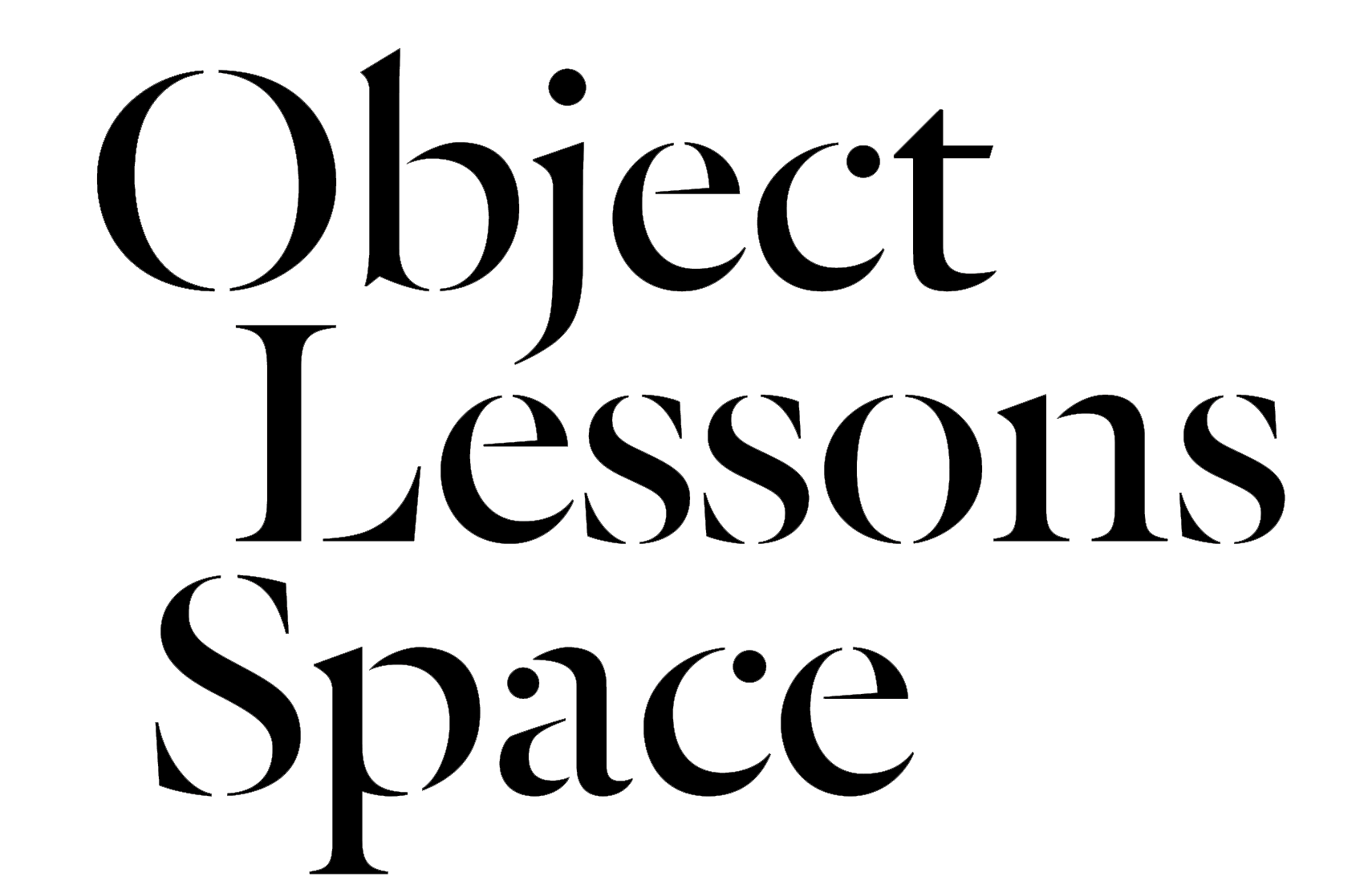Slow
Conversations
Issue: On Technological Materiality
Issue: On Technological Materiality
Chok Si Xuan is a sculptor and installation-based artist whose practice is heavily influenced by technology and science fiction. Her works explore cybernetic systems through an enquiry into the body as a site of virtual and corporeal convergence. Through constructing a visual language, she aims to bring out the emotive and intimate physicalities in the way we relate with one another. She also draws from contexts of increased automation and symbiotic relationships within local ecosystems to experiment with artworks that consider audience interaction and activation. She works with a range of materials including found objects, silicone, metal with a focus on producing kinetic and gestural elements through electronics, motors, 3D printing and sensors.
Filed under: found objects, installations, sculpture, technology


¹ Non-things: Upheaval in the Lifeworld, Byung-Chul Han
2022
To open our conversation, let’s begin with a book you picked out for our conversation. In Non-things: Upheaval in the Lifeworld, philosopher Byung-Chul Han writes about our contemporary reality in which virtual information and communication has displaced the object. Could you tell me about why this book has been at the forefront of your thoughts and research, and how it broadened your perspective?
I had been recommended the work of Byung-Chul Han, and I found this book that he had recently published. I resonated a lot with its initial premise. I wanted to further understand how he had arrived at a similar understanding as I did — that information has come to define our world which has increasingly become de-materialised — but I wasn't really sure how to begin teasing out these ideas. I think his book was useful, as he dissected things in a methodical way that was very clear to understand.
One important concept he discussed was the informatisation of things, which refers to the process in which we convert objects into information, or when information then becomes the most important thing. It is more important what something conveys in a material reality, even if those connotations are abstract notions such as comfort, happiness or luxury. But as a result, things, places, textures, and sensations become dull. They are no longer at the forefront of our experiences, and have less influence on the formation of our identity. At the same time, things are also very important. Han was trying to convey the continuity and sameness that things provide, and how this can be traced back to a foundational identity. We need these things to experience our own corporeality. This really clicked for me.
I’ve been trying to reconcile my making and my research. What Han wrote in Non-things became a starting framework for the way I engage with my practice. In thinking about the technologies and devices we have created, I was trying to entangle how technologies have informatised things, whilst highlighting the importance of things.
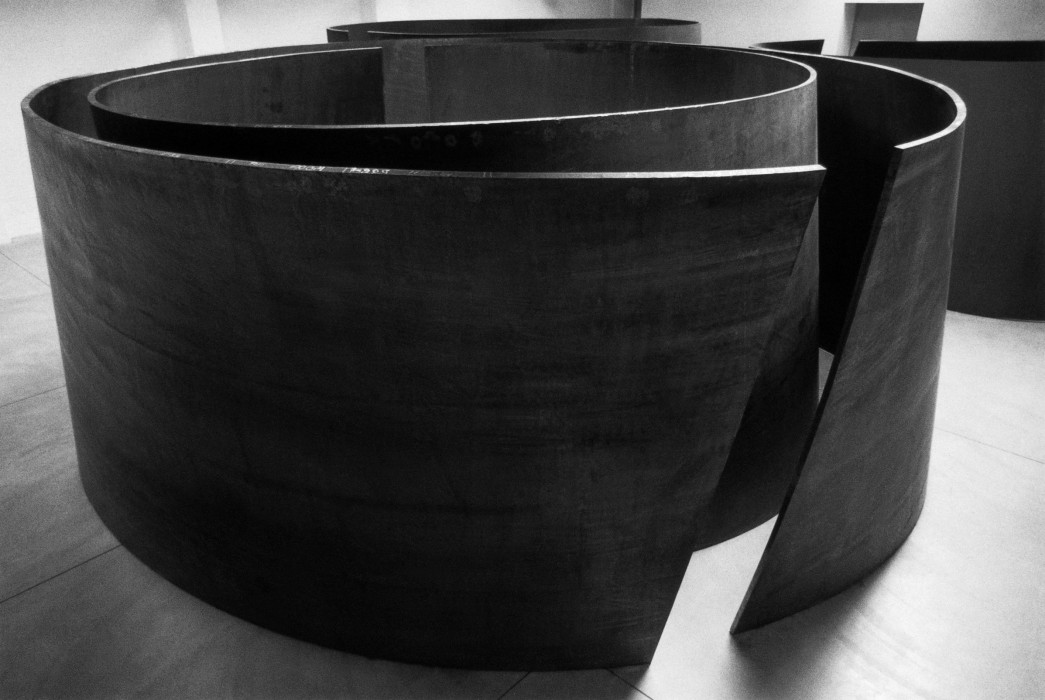
² Double Torqued Ellipse, Richard Serra
1997, Installation view at Dia Art Foundation
As you pointed out, despite the dematerialisation that accompanies the informatization of things, Han asserts the importance of “things” to anchor and give human life stability. I like what he calls “a firmness of being”, which he also relates to truth and groundedness. This recalls another artwork you have chosen for this conversation, Richard Serra's Torqued Ellipses, which destabilise our physical experience of space and defy complete visual understanding. In what way does this artwork help you think about the corporeality of the body and perception within space?
My initial reaction to the work was that the space it was set within was actually quite small. It felt deceptively contained. Yet the more time I spent in it, the more I started to see how the contrast of textures between the brick walls and the patina on Serra’s mild steel created a continuity. I think it transformed a very expansive space into one that was carefully segmented. At the same time, it felt rather intimate. I chose this work because it was my first time experiencing monumental and large-scale works as they are not common in Singapore. I thought it was actually a very small space, but I realised it was huge once I started going into the ellipses, which was quite destabilising for me. There were probably ten other people in the space around me, but they were mostly obscured and I was alone for the most part because of how large the work was. I was trying to understand these sensations in contrast to the other spatial sensations of air quality, light, sound, and the presence of echoes throughout the space. I was excited about all these different experiences, and that I was challenging my own perceptions of space.
³
////;;;;body remade, Chok Si Xuan
2019
2019

⁴ Screenshot from Taobao Media, Tumblr
You've also picked out Taobao Media as part of your selection of objects. It’s a website that features strange product images found on the Chinese e-commerce platform, Taobao, without any context or description. It reminds me of how you also work with notions of simulation. For example, your reconstruction ‘failed’ 3D printed parts in some forms of failure, quality control speaks to 3D printing as a method of replication. Separately in an earlier work ////;;;;body remade, silicone is used for its textural qualities that mimic human and animal skin or membranes. Could you tell us more about your interest in the act of simulation, and the gap (or proximity) in their fidelity to the original?
When you talk about simulation and fidelity, these are concepts I was thinking about but had not connected with my practice just yet. I feel like you’ve connected them well. I source a lot of my materials through Taobao. I realised that it could be an extension of my experience in producing the work. I enjoy observing the strange algorithm that Taobao has. I was trying to figure out why these strange and surreal images were being attached to products that could actually be very inane. I was also interested in why these images are created. Perhaps they were made to increase viewer engagement as people might click on it out of sheer curiosity or repulsion. But in some ways, I realised that specific engagement was also the way I approached my work. The more interesting and intriguing they were, the less apparent the function of the object. Rather, the context would capture your attention instead. I think that attention is also rather important. The meaning of the work or other kinds of textures and movements will only come through when a viewer dwells on the work.
I think it is also connected to my interest in the uncanny, and this combination of fascination, repulsion, and confusion. I’ve always been thinking about the strategies I can employ to generate such an effect. I usually take an instinctual approach to the selection of materials. I also think about the notion of utility versus ornamentality. Some have commented that I turn useful things into useless objects in making my works. It’s partly true. I am trying to articulate other aspects of these objects’ physicality, aspects which are often overlooked precisely because of their utility. But I'm also not rendering them entirely useless. You can still see elements of the original object in my work, for example the motors in the massagers or the exposed wiring. I'm focusing on the sculptural quality of the thing itself, rather than completely eradicating its original function. I think it also clues in to the kind of life the form could possibly have lived.
I'm focusing on the sculptural quality of the thing itself, rather than completely eradicating its original function. I think it also clues in to the kind of life the form could possibly have lived.
⁵
iiiiiiiiii, Chok Si Xuan
2022
⁶ iiiiiiiiii, Chok Si Xuan
2022
2022
⁶ iiiiiiiiii, Chok Si Xuan
2022
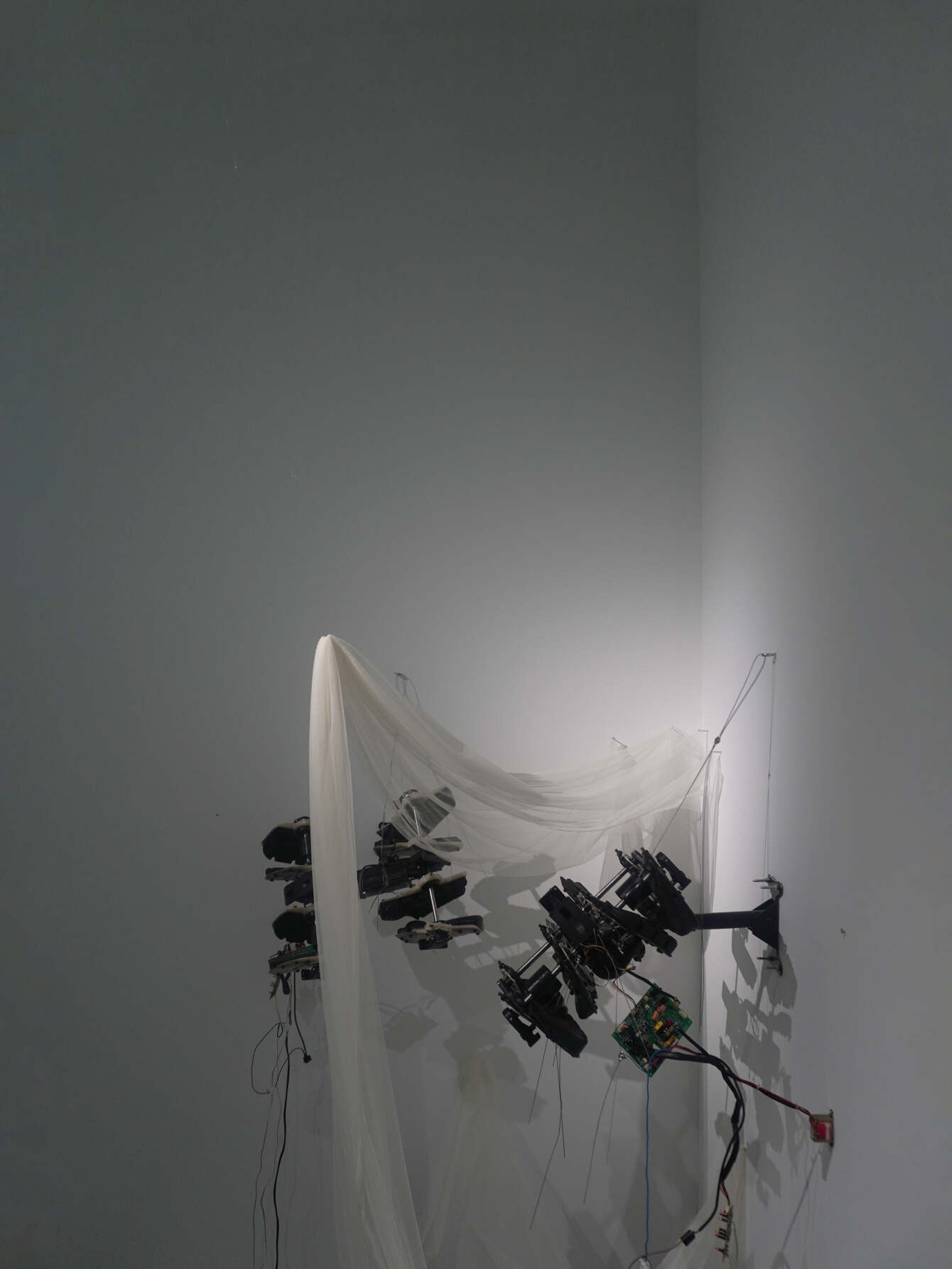
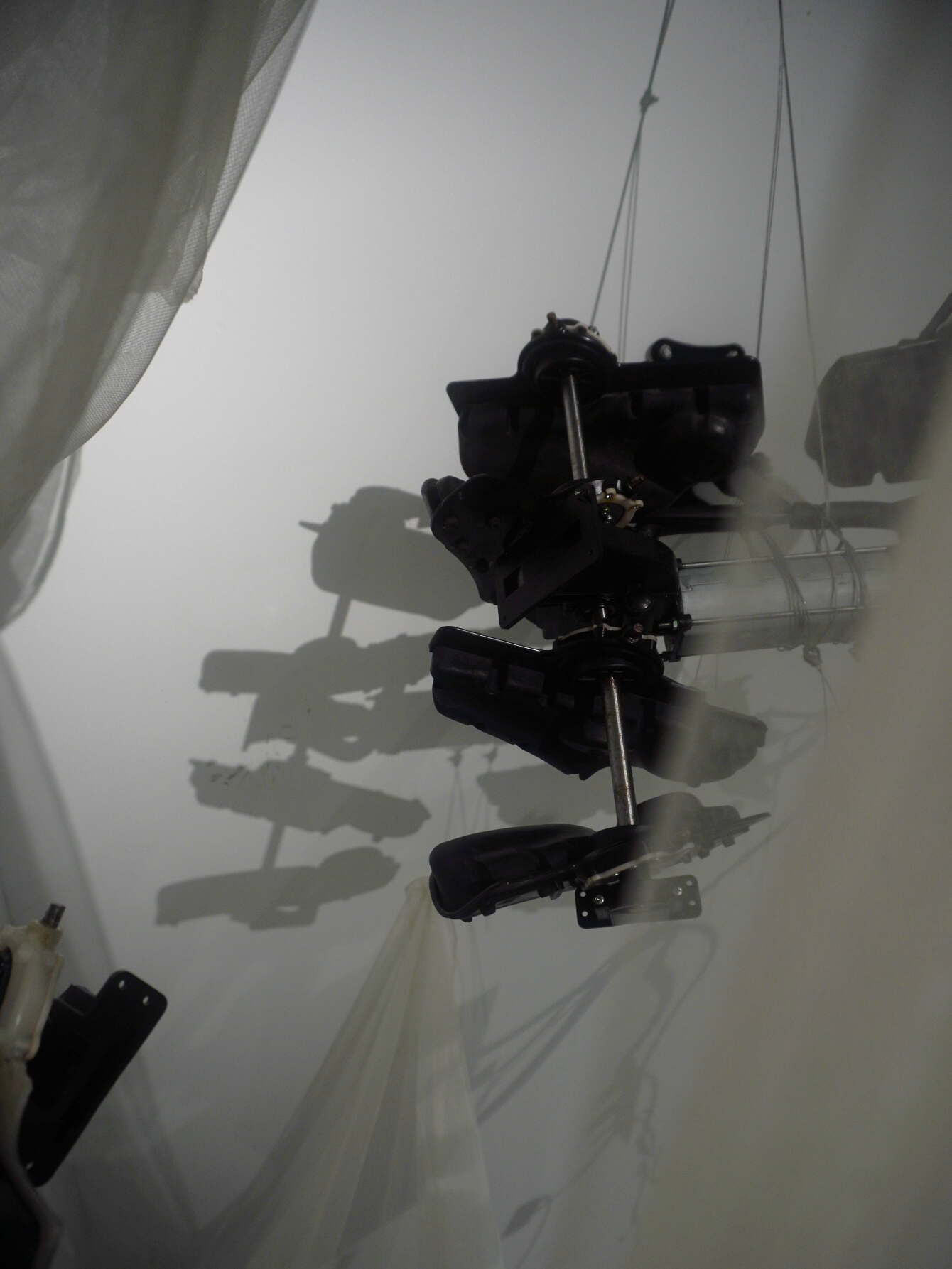
In relation to your recent works where you’ve deconstructed massagers, I was also thinking about how these devices have multiple inner contradictions and desires. Of course it's meant to mimic a human action, but it’s also a mass-produced, purpose-built device. Could you tell us more about how you were led to this particular object, and what you seek to reveal by intervening in the structural makeup of found objects?
In a previous work, latent, I was interested in biological systems of breathing and began to try to understand and reproduce them in a very clumsy way. In the process of making a few iterations, I realised it was possible that a similar appliance or a system already exists, separate from me constructing it from scratch. I thought I could find existing objects and hack them.
Later, I realised it also brought up a multitude of meanings because such objects clearly had another life before and a different utility that it performed in the commercial world. I found a pneumatic system with airbags that inflate and deflate, and it was a back massager that would have been embedded in a car seat. That was how I started to think about massagers — in realising that there's something that I'm trying to engage with the body. I'm simultaneously using a machine created for the body, within a system that has been produced in service of the body.
⁷ latent, Chok Si Xuan
2022, Installation view at Starch
⁸ latent, Chok Si Xuan
2022, Installation view at Starch
2022, Installation view at Starch
⁸ latent, Chok Si Xuan
2022, Installation view at Starch


Another recurring fascination in your practice is the simulation of internal circulations: machine-driven movements which mimic muscle contractions, the pumping of air to simulate rhythmic breathing, or the circulation of water through tubes. I see this as slightly different from your use of massagers, which seem to be performing an external action on the body, but also one that speaks to relaxation and luxury, rather than essential life processes.
Yes, you’re completely right. Previously, I was trying to engage with systems or gestures that were more internal. On the other hand, massagers are very external. I think it addresses a more social concern because the massager aims to replace the sensation of a person massaging you. That led me to think, “Why are we not in service of each other? What leads us to require massages? Is it a natural human need because the tensions within the labouring body needs to be soothed by way of a massage, or does it provide an intimacy that we lack?” It seems that there's a level of avoidance that leads to the creation of machines that we may delegate these kinds of labour to. We want the convenience of having a massage but we don't want to ask someone else for it. We want to make friends with people, but we don't want to approach someone on the street. We are trying to move away from each other, but yet we desire that intimacy.
Your works think a lot about intimacy: between machine and maker, the synthetic and the biological, or between the digital and the tactile. Why is an experience of intimacy important for you?
I think intimacy is a complicated thing. I didn’t really know how to address intimacy until I began engaging with materials. I realised I had to first address the intimacy between the materials and myself, as the producer of the work. When I am present and focusing all my attention onto making, I am staying with the work, either being frustrated or excited about it, and I think that that is such a valuable experience to have. I also feel that intimacy seems to be something that's quite rare, but something that can also be cultivated. It was an aspect that I wanted to focus and work on within my practice. It's a message not just for the work and for its viewers, but it’s also for myself to be in constant practice with the things around me and the people that I find to be important.
In Non-things, Byung-Chul Han also writes about care. The over-technologizing and creation of devices which were supposed to become solutions or point us to different ways of living somehow “de-cares” us because we don't need to depend on one another anymore. These devices substitute the gestures and the help that we need. My practice aims to address the “de-caring” that takes place in the rift that information and a lack of focus on material reality creates. I want to use my practice as a way to situate our bodies within our environment and focus that attention on the things in front of us. That was how I felt when experiencing Serra’s work. I wanted to highlight the experience of taking the time to engage your senses and with the objects within space. My work also asks for the time of anyone who enters. Without time, a bond cannot be created. To spend time, as I do when I work on my machines or code, is also a way for me to show I have an investment in or care for that work. It counters the hyper-technologised nature of our everyday.
My practice aims to address the “de-caring” that takes place in the rift that information and a lack of focus on material reality creates. I want to use my practice as a way to situate our bodies within our environment and focus that attention on the things in front of us.
⁹ synapse, Chok Si Xuan
2021
¹⁰ synapse, Chok Si Xuan
2021
2021
¹⁰ synapse, Chok Si Xuan
2021
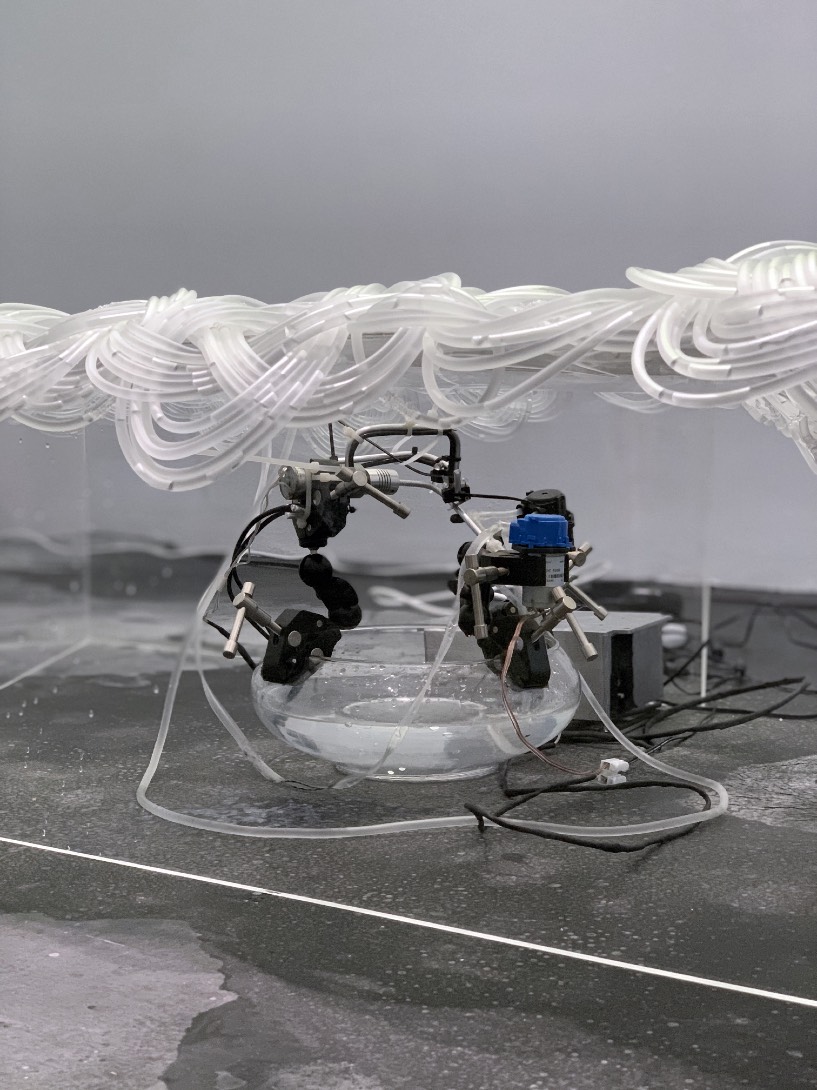
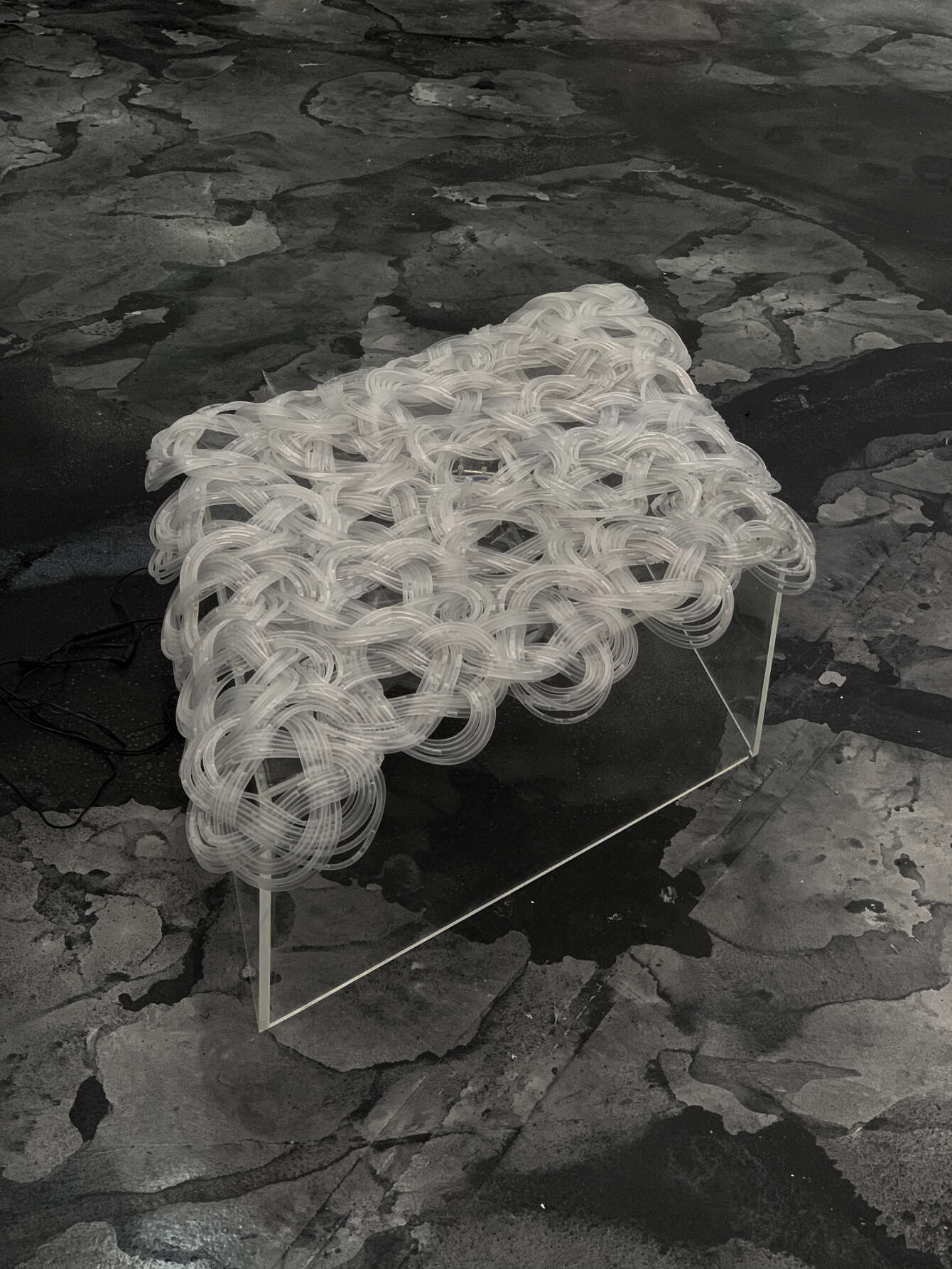
When it comes to generating this intimacy with the viewer, what are certain considerations that you have?
I operate quite intuitively and so I usually observe, experience, and make adjustments. I might, for example, adjust the amount of time that a work gets activated. In the same way that video works ask for a segment of our time, the way I activate my work is also to tell the viewer: this is how long it's going to go on for, and you are more than welcome to stay beyond that if you choose to, but I hope that you will at least stay to see it run its full course once. The choice of engagement is entirely up to the viewer. At the same time, my works are quiet most of the time. The stillness in between activations is also a conscious choice. It allows people to walk out if they want to, or gives them the option of staying.
It feels like there are moments in your work where it is active and awake, and moments where it is resting and quiet. Beyond your interest in biological systems, your other artworks adopt recurring motifs such as flowers, insects, organisms, which explore the confluence of the natural, the synthetic, and even the extraterrestrial. Why are you drawn to these hybrid imaginations and what motivates these interests?
I think my inclination is akin to a hope for the world. I recently answered a similar question: What kind of world do I hope to imagine when I produce my work? I’m definitely thinking about how we can technologise and implement new mechanical and digital systems that harmonise with the world, but I think the contrast between the synthetic and the biological is always important. It’s not that they cannot exist together, but that it’s more exciting when they are in tension. My interest is always in a balance, even between the brutal and the delicate. One cannot exist without the other.
I’m definitely thinking about how we can technologise and implement new mechanical and digital systems that harmonise with the world, but I think the contrast between the synthetic and the biological is always important.
¹¹ latent (bbb edition), Chok Si Xuan
2022
¹² latent (bbb edition), Chok Si Xuan
2022
2022
¹² latent (bbb edition), Chok Si Xuan
2022


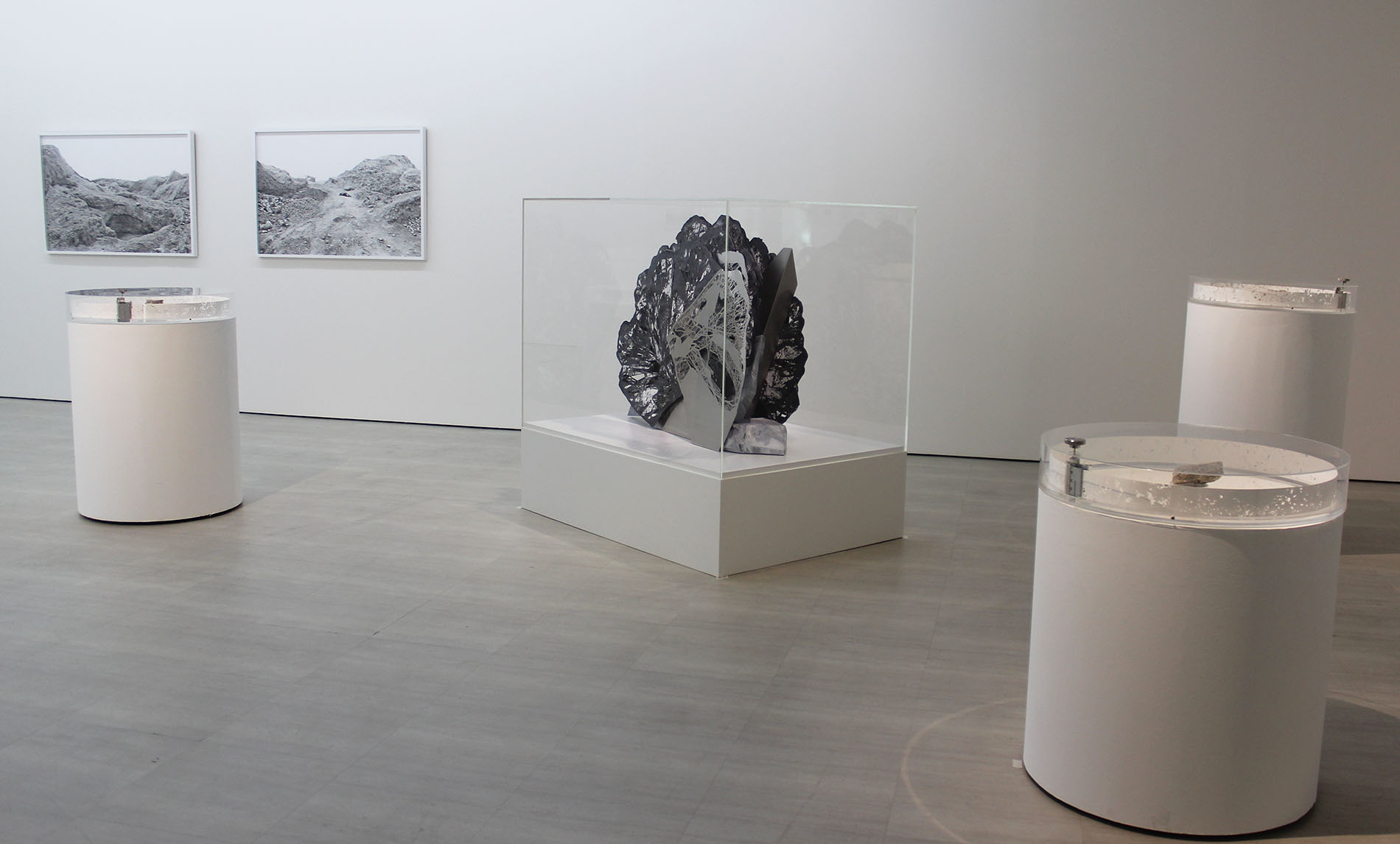
¹³ If you can dream a better world you can make a better world or perhaps travel between them, Melissa Tan
2016
Another artwork you had picked out was Melissa Tan's If you can dream a better world you can make a better world or perhaps travel between them. Its intricate paper and metal cut sculptures speak to the rapidly changing urban landscape of Singapore, and translate visual elements into sonic expression. What affinities do you find yourself drawing with this work?
This was one of the earlier works I saw even before I started studying art. The fact that I remembered it meant that it had a strong significance to me. I realised that works that demonstrate a system within and highlight material qualities are usually the ones that impact me the most.
Seeing how a “musical box” made out of the meticulously cut paper textures turned into sound was a very exciting moment for me. Cut paper became a score, almost as instructional code that translates texture into sound. As a student at the time, to imagine someone had this idea and constructed this mechanism for everything to work in a particular way was very exciting for me. There's also a tenderness that really spoke to me in Melissa’s work, as can be seen in the title. I’d seen this work even before I really thought about making artworks myself, and it left a strong impact on me.
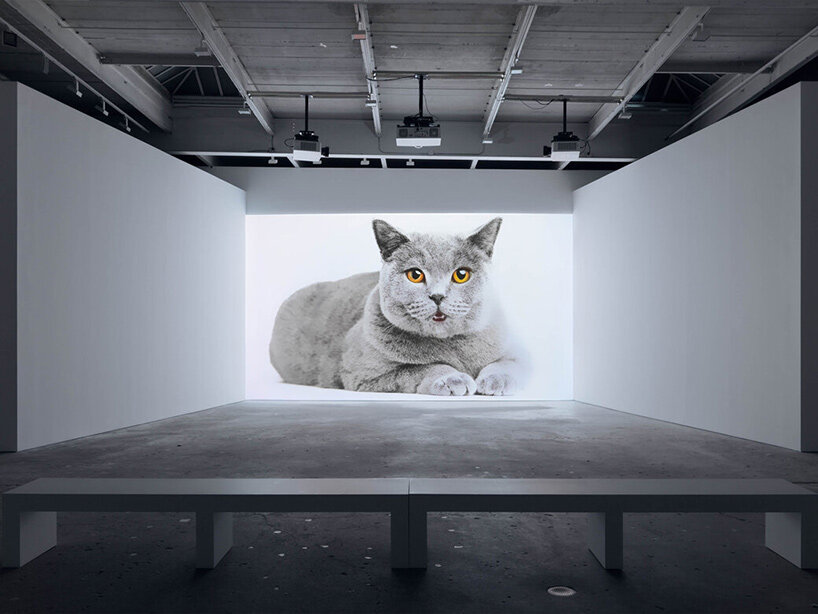 ¹⁴ Untitled (No Comment), Barbara Kruger
¹⁴ Untitled (No Comment), Barbara Kruger 2020
I see how some of these elements are still things that you think about and drive your practice today. You had also picked out a recent video installation you saw in New York, Untitled (No Comment) by Barbara Kruger. Known for her use of images and text to question established power structures and social constructs, this three-channel work rotates rapidly through a range of materials from found memes and internet culture, shedding their original contexts and taking on new meanings as they circulate. This reminds me of your work, some forms of information, which draws on TikTok videos as the distribution of alternative forms of knowledge, and your meme-related workshops. Could you tell us more about how digital content and memes feature in your practice, and how they have shaped the way you approach art-making?
I was very interested in the idea of alternative forms of information and knowledge. I think of memes because they are extremely accessible and quite enjoyable. The accessibility is not just in making, but also in understanding and how it signals the dominance of the image over text as the main medium of communication. I also consider how people quickly and efficiently engage with their own subjectivities in the production and engagement of this content.
When I saw Barbara Kruger’s Untitled (No Comment), the way that she started out with typefaces before connecting it to memes and found footage online was very exciting and punchy. It evoked my own familiarity with engaging and consuming information through my phone or computer. I think this familiarity can be utilised in some form or shape when I produce my work. With the workshops and some forms of information, they were testbeds for me to engage with digital culture and platforms in a way that also tries to comment on it. However I have yet to resolve why, how, and what am I trying to say just yet.
My current interest is to think about the present. Many people have the perception that my work thinks about the future, but really, it’s always about engaging the present. I'm always thinking about contemporary culture and current technologies. Memes and meme-like media are constantly being produced, shifting very quickly and altering our perception of time. I think that it's also a way that time can be captured and almost fossilised to produce the zeitgeist of a particular moment.
My current interest is to think about the present. Many people have the perception that my work thinks about the future, but really, it’s always about engaging the present.
Beyond your own practice, you often collaborate with other artists to produce works. What has been your experience in such collaborations, and has this changed the way you perceive or approach your own practice or art making?
As part of Experiments in Networked Performance, a course I took at the School for Poetic Computation in New York City, we only had a day and a half to produce a work. I had to work with two artists in this very short period of time: Erika Choe, a dancer and product designer; and Tyler Yin, a designer and artist whose background is in creative coding. We were very fortunate to be aligned in our ways of working, and we were all just throwing ideas out. I came up with a basic premise, but they really brought in their own interests. For example, they were interested in engaging with the digital effects of having someone's bodily gesture move with particles on the screen. We really didn't have time to think about whose role was larger than whose, so we were operating on very equal footing. It was exciting to see people saying things such as, “I'm okay if my idea doesn't get included”. Everyone tried to accommodate each other, and I hope that more collaborations can be like that.
That is because collaboration can be a tricky thing. Sometimes we feel that if our involvement does not seem as pronounced, or if the creative direction doesn’t align, then it might not be a “successful” collaboration. But I think a lot of it has to do with trust and understanding. If everyone operates on that basis, the collaboration can open up new avenues for everyone to learn from one another. This experience has affected the way I worked and pushed me to be more interested in participatory and collaborative work. I was previously part of Egregore, organised by Brandon Tay with many other musicians and artists. I was initially worried about how we were going to create one thing that could accommodate everyone's skills and interests, but everyone was very accommodating and trusting of each other, and I was very fortunate to learn from them. Perhaps it's also the way that musicians work. Musicians require producers and engineers to be part of their process, which can be quite different to visual artists who tend to work alone. It’s something that I've got to be open to.
¹⁵
within and without (i), Chok Si Xuan
2023, Installation view at Hatch Art Project
¹⁶ within and without (i), Chok Si Xuan
2023, Installation view at Hatch Art Project
2023, Installation view at Hatch Art Project
¹⁶ within and without (i), Chok Si Xuan
2023, Installation view at Hatch Art Project


To wrap up the conversation, you have mentioned that your approach to experimentation takes in “moments of system failure” as productive, and the (un)reliability of technology as a way to highlight the interdependency of systems. Could you tell us about your relationship to technology, “failure” and process?
My relationship to technology in my practice is rather frustrating, but also quite endearing. The world we live in today is filled with different tools and systems that we’ve devised to deconstruct and reorient information. There is an assumption that technology is infallible yet subservient, meaning that it has to be easy and intuitive to understand so that it may serve us, but I realised that it often does not fulfill that. There's always a gap or there are lapses in behaviour that manufacturers and designers can never fully accommodate.
I also have to admit to having these moments of failure myself. The first is perhaps in my understanding of the technology, as I do not come from an engineering or computer science background. I don't take it as a shortcoming, though. Things could go terribly wrong, or it could lead me to discover a lot of exciting things. It can be a productive confusion to work with. The second failure is often the environment. We might think that technology is infallible, but it actually is very susceptible to things that humans are also susceptible to. Once it is exposed to humidity or water, or it gets overheated, everything shuts down. The last kind of failure is more of a less-intended outcome. I think it is the most exciting process, and it’s the way most of my work actually functions — and that is to create new things by capturing overlooked aspects of technology. This process really questions my inherent assumptions of things, as I cannot claim to know how to control everything. In letting the appliance guide me in its material, physicality and function, I am also relinquishing some of that agency to the materials I'm working with.
